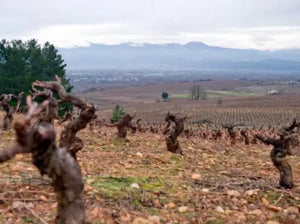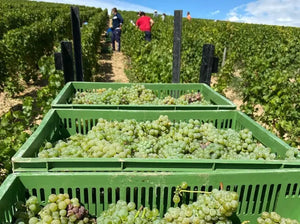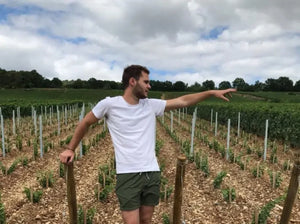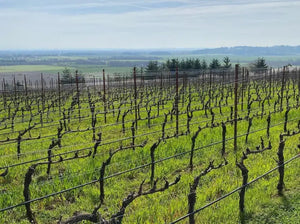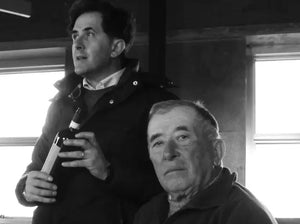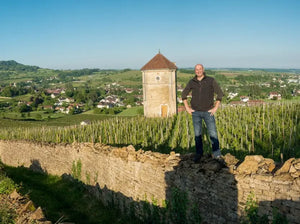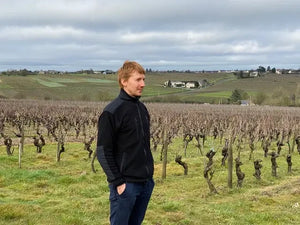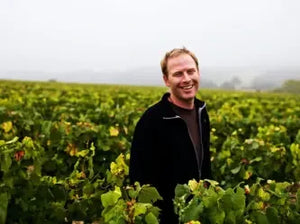Blog » White
-
Heaven Sent Albariño: Nanclares y PrietoLegendary U.S. importer José Pastor has been the gateway to many new Spanish discoveries, including Envínate and Luis Rodriguez. Alberto Nanclares and Silvia Prieto in Rias Baixas marked a massive shift in my understanding of descriptors like "crystalline" and "acid-driven" regarding Albariño and the Spanish white wine category as a whole.Like Vincent Dauvissat's Chablis, an element of clay in the soil (mixed with decomposed granite) gives these wines a gorgeous texture that stands out from the rest of the pack. Nanclares y Prieto produces a powerful and saturating style of Albariño still founded upon fresh citrus and orchard fruits, with a salty, long finish. These have become my Spanish white obsession over the last few years, and I take every single bottle offered from José.
"Alberto Nanclares": The flagship wine of the estate. A blend of eight east-facing parcels on decomposed granite and sandy loam. Aged in used French oak barrels.Soverribas: Vines up to 100 years old from three west-facing parcels on sandy, granitic soils with clay deposits. Fermented and aged in a 2200L neutral French oak barrel.O Son Das Pisadas: 100% Mencia from the ‘Eira Padín’ parcel in Rias Baixas. Vines are trained high in the espaldera method. Soil is sandy loam over granitic bedrock.Minato da Rana: 100-year-old Mencía and Garnacha vines on granite in Ribeira Sacra, supplemented by 10% Palomino and Godello. -
A Star in Central Portugal: Textura
The Dão is unique. Resistant to the Atlantic influence that characterizes so many of Portugal’s wine regions, this little enclave of viticulture exists to defy expectations. One of the projects highlighting the possibilities within the region is Textura. Beginning in 2018, the project pulls from over 20 hectares of organic vineyards within two subregions: Castendo and Serra da Estrela.
The approach to winemaking at Textura shows a commitment to low-intervention practices that have served winemaker Luis Seabra well. His consultation and guidance have left their mark on Textura’s lineup, with “Burgundian” being a term used to describe the wines. Especially evident in wines like Textura da Estrela, judicious use of oak, a pinch of reduction, and natural acidity integrate into an enticing, racy wine that pairs with a huge range of cuisines.
What’s distinctly not “Burgundian” here are the grapes. While varieties like Encruzado, Arinto, and Gouveio don’t have the international recognition of Chardonnay, they deliver vibrant wines full of character.
In Dão, like so many regions of Portugal, the blend is key. The wines here are all about harmony. The floral and tea aromas, citrus, and orchard fruits like pear all emerge from the modest veil of reduction in wines like Pretexto, while the deep well of concentration present in Pura gives the impression of a wine worth waiting for, though it is singing at present.
No country has jolted our team over the last year like Portugal. Wines like those of Textura have the salinity and mineral punctuation with perfectly judged ripeness of fruit that has simply thrilled us. -
Florence Cholet: Burgundy's Best Kept SecretFlorence Cholet's under the radar wines
-
Bitouzet-Prieur: Classicism Holding Steady
We all have regrets. One of mine was passing on Bitouzet-Prieur Volnay and Meursault when I turned on the lights in 2015. A friend once said, “If you’re not embarrassed by choices made in the previous year, then you’re not growing.” The 2020 vintage of this domaine marks my redemption.
With winemaking medals galore filling the home of Vincent Bitouzet back in 1860, the marriage to Annie Prieur after that marked the official start of what is now the most classic domaine in Volnay, along with Lafarge. And the whites from vineyards like Meursault 1er Cru Charmes and Perrières are now another great reminder that value is alive and well in the Côte de Beaune.
I only have a few wines from Bitouzet-Prieur, but they are the best cuvées to me after an extensive tasting with the domaine in Brooklyn last year. The Volnay is destemmed, and pigeage (punchdowns) occur twice per day—a process that has seemingly gone out of fashion in Burgundy of late as many opt for remontage (pumpovers) to bring softer contours and more immediacy to the fruit. But the 2020 Volnay is pure class and is precisely the type of Burgundy I seek out—from the greatest red village of the Côte de Beaune.
The whites see extended lees contact and a maximum of 20% new oak. They pull back on the fruity Chardonnay traits, instead digging deep for a saturating mineral through-line that reminds me of wines common pre-2005 heat. Still bursting with site-specificity and deliciousness, they take my mind back to another time with their soft-spoken spirit. -
André Ostertag: Alsatian Sensation
Domaine Ostertag has long gone against the grain of Alsatian expectations, crafting dry, disciplined wines that still summon the sunshine that marks the region. His Fronholz and Grand Cru Muenchberg Rieslings especially imbue the transparency and purity of a mountain lake. These wines are a moment of clarity for Alsace!
Alsace is in the cool northeast pocket of France, and its protection from the Vosges Mountains means it receives the least amount of rainfall of any region. This abundant sunshine has long given Alsatian wines a rounded and golden orchard fruit quality, often with a dollop of residual sugar. However, several elements separate Ostertag from the norm. André studied viticulture in Burgundy and returned home in 1998 to employ organic and biodynamic principles in the vineyard. He also decided to ferment his Rieslings completely dry and age them in stainless steel.
Today, Alsace is famous for having the highest percentage of organic and biodynamic producers in France. While the quality at harvest couldn't be higher, I still find few producers that execute with the same sense of harmony that Ostertag is adored for. -
Etna's Grand Cru Carricante: Benanti
Many have sought to express this distinct terroir from the eastern slope of the volcano, but one family is most synonymous with the greatest heights it has achieved. Etna doesn't have a classification system to rank estates or vineyards like Bordeaux and Burgundy, but if there was one Grand Cru white from these volcanic slopes perched over the Mediterranean, it would surely be Benanti's Pietra Marina.
Sourced from 80-year-old vines, Pietra Marina showcases Carricante at its most structured and age-worthy. While salinity is a hallmark of this grape variety, the defining element here is a tightly wrapped core of citrus, orange peel, and almond. There's a frame and touch of austerity to Pietra Marina that shows a discipline worlds apart from the more oxidative and plush style of wine commonly found in Milo. In the end, it's the vein of minerality and grip that appropriately put this benchmark bottling on the table with top Chablis and Burgundy.
Benanti's story began in the 1800s, but it was in 1988 that the estate began to garner fame. Giuseppe re-examined and questioned every aspect of Benanti's viticulture and winemaking, challenging conventional wisdom on clones and their compatibility in each parcel. Aging in stainless steel is a crucial element in keeping this southerly white wine so fresh and crisp. But make no mistake—it's these same qualities that give Pietra Marina its backbone to age in your cellar for many years to come. -
Bona Fide Naturalist: Werlitsch vom Opok
Wineries like Werlitsch in Austria's Styria region perpetuate those dreamy biodynamic farm vibes we've seen springing up in Eastern Europe. Sure, the scenes are breathtaking and make for a good selling point, but what winemaker Ewald Tscheppe produces from his opok-rich soils restores our faith in the far reaches of natural wine.
Our team once blind-tasted the Ex Vero I together. It had a matchstick quality on the nose, followed by white florals, fresh citrus, coconut milk-like texture, and electric acidity on the palate. Still, the wine's focal point was its lively energy and slightly waxy texture. I guessed it was from the Jura, thinking it had a Burgundy gone rogue feeling, but it turned out to be a blend of Sauvignon Blanc and Morillon (aka Chardonnay). Ex Vero is a three-part series showcasing the varied levels of altitude and soil composition on Werlitsch's steep hillside. These vines grow on limestone and clay soil rich in minerals and marine fossils, which locals refer to as opok. Frankly, the wines are unlike anything you'll taste from Austria or elsewhere.
Ewald and his friends discovered biodynamics while studying wine in the early 1980s. As a true devotee of the naturalist movement, he believes that nature always does it better—for him, that means gravity-flow winemaking, natural yeast, no temperature control, and no sulfur. In 2004, Ewald began to apply biodynamics to his family's estate, which also inhabits fruit trees, wild herbs, vegetables, and forests. -
Spanish Mic Drop: Raul Perez Atalier
It's hard to comprehend how one producer, like Raul Perez, can redefine the Spanish white wine category. His most monumental wine is Sketch, an Albariño sourced from a 0.5-hectare parcel of old vines in Rias Baixas, priced at $100-plus per bottle. It's worth its weight in gold, but upon release, rumors swirled that his other Albariño was going to be the proverbial mic drop moment for the variety.
Our go-to Atalier bottling, "A Cruz das Animas" comes from two parcels of Albariño vines in the Cambados area of the Salnés Valley, located in the southern portion of Spain's northwest tip. And today, we're adding "La Encrucijada" from Atalier's oldest and most sea-adjacent vines, which sees extended aging in barrel (About 14 months) on its fine lees before bottling. Raul's greatest influence is white Burgundy, and he takes every step possible to preserve Albariño's cut and delineation iwhile also pushing for maximum ripeness and flavor development.
The key steps are harvesting very late and then blocking malolactic fermentation, which allows for superb ripeness but eliminates the more viscous and creamy elements of Albariño that don't appeal to Raul. Aging is in older French foudre, which preserves tension and softens texture. Perez redefines what a mineral-driven Spanish white wine is capable of, showing the same depth and nuance I expect from Chablis and Côte de Beaune Chardonnay. Simply put, his Atalier over-delivers. -
Sancerre Secret: Vincent Pinard FlorèsOne thrill of living in Beaune in 2012 was getting familiar with an enormous range of Burgundy producers. Beaune had its fair share of wine bars, and none devoted serious space to wines outside the region. That changed when the natural-focused Les Vins de Maurice opened in the spring, where wines from the Jura, Rhone, and Loire Valley covered the walls.
One day, I asked Maurice to introduce me to a new producer doing something unusual, and he quickly picked up a bottle of Vincent Pinard's Sancerre. I've been hunting for his wines ever since, brought to the U.S. by the same importer as Mugnier, Comte Liger-Belair, and Lafarge.
Pinard is in the village of Bué—some of the most prized vineyards in the region are here (alongside Chavignol). His wines are overtly stylish, each cuvée standing apart from one another. They have intense concentration and a gossamer texture that bears little resemblance to what we commonly expect from Sancerre.
Florès comes from a collection of vineyards in Bué. Aged in stainless steel tanks, the racy and crispy classic Sauvignon Blanc citrus notes mesh perfectly with Pinard's more layered and textural style. When fall hits, and I reach for Sancerre, this is the kind of secret overachiever that delivers! -
Leaping Over Legacy: Pierre Girardin Bourgogne
Vincent Girardin's name was synonymous with Burgundy's breadth, with wines coming from enviable vineyards throughout the Côte d'Or. Although the vast terroir had undeniable gems from Grand Crus and Premier Crus, the large production made for boring wines. When Vincent sold the domaine in 2011, he kept 4.5 hectares of the top holdings for his son, Pierre. After spending time in the vines, cuverie, and cellar from a very young age, the 21-year-old Pierre wanted to take a different philosophical path with his label. He was determined to be associated with the highest quality work––albeit with much more limited availability.
As the cuvée's label suggests, calcaire (limestone) is what Pierre wants to express, and the lens of terroir is in focus with these terrific Bourgogne wines. Pierre's methods highlight freshness and finesse––a rare move was selecting considerably larger 456L barrels for aging and favoring punchovers (as opposed to punchdowns) for the reds to keep their tannins silken. The value proposition in Burgundy is one that we bring up a lot. No doubt, pricing keeps climbing, but the emergence of new values is always around the corner. Pierre Girardin is a name that delivers in a big way with a relatively low price tag, given the quality and terroir. -
New Venture in Willamette: Walter Scott Aligoté
The pinnacle of the range from Erica Landon and Ken Pahlow of Walter Scott rests with their X Novo and Seven Springs Vineyard Chardonnays, though the Pinot Noirs are also among the best in the U.S.—the 2019 Bacocho Pinot Noir is a favorite. These are Grand Cru-level expressions of Willamette’s Eola-Amity Hills!
You'll also find a new addition to the lineup. The Williams family has been farming X Novo Vineyard with organic practices for over a decade. It’s now considered one of the most renowned sites in the valley. In 2018, they acquired an additional 40 acres neighboring X Novo, including the X Saxa Vineyard, originally planted to Riesling. They quickly grafted the vines over to Chardonnay and Aligoté. For a region that’s largely inspired by Burgundy, it’s still quite rare to find Aligoté in Oregon.
The X Saxa Aligôte and X Novo Chardonnay are reference points for Walter Scott and their touchtone finesse. Pahlow's harvests alongside Dominique Lafon in Meursault left their mark, as his white wines elicit a similar noble reduction and filigree. Compared to the Chardonnays, the Aligoté has even more alluring aromatics and opulent notes of pear blossom and green melon on the palate. If Aligôte in Burgundy can often verge on lean and pleasing, then X Saxa challenges that notion with its fruit-forward nature, tension, and seamless texture. -
Trebbiano on the Skins: Paolo Bea Arboreus Bianco
Paolo Bea is most famous for its wildly interesting take on Montefalco's Sagrantino red grape variety, but today, I’d like to pivot to their orange wines. Paolo's son, Giampiero, was one of the first naturalists in Italy to adopt the practices of Josko Gravner and Stanko Radikon (the Friulian winemakers who repopularized the ancient-old tradition of fermenting white grapes on their skins). Today, Bea’s Arboreus is considered a benchmark in the world of orange wine, and it has a fascinating backstory.
These Trebbiano Spoletino vines were planted below oak trees on the Paolo Bea estate over 120 years ago and have completely wrapped themselves around the trees (Hence the name Arboreus). Once harvested and de-stemmed, the grapes ferment on the skins for several weeks and spend a minimum of two years on the lees in stainless steel tanks. Gravner and Radikon produce the most concentrated, structured examples of orange wine you’ll come across and are undoubtedly the pinnacles in this category. I more often gravitate toward Paolo Bea's style, though. Arboreus has that same deep amber hue, golden stone fruit showing apricot and yellow plum, powerful tannins—but with an added streak of freshness that balances its other components. Note: This is a great food wine with the tannins to take one heavier foods than typical whites (Lamb kabobs and saffron rice were on my mind when we tasted this).
If you prefer your orange wines, well, less orange-y, consider Lapideus. The grape variety, soil type, and winemaking are the same as Arboreus (same skin-contact and élevage regimen). Except, these 80-year-old Trebbiano Spoletino vines, trained in the traditional cordon method, grow in a cooler microclimate, resulting in a leaner, more acid-driven orange wine. Paolo Bea provides a counterpoint to the argument that this style of wine can’t be terroir-driven! There are also Monastero Suore Cistercensi’s orange wines, Coenobium and Ruscum, as value-driven options. Based in Lazio, these wines are farmed and produced by the Sisters of the Cistercian order, with some guidance from Giampiero.
Lastly, I highly recommend reading Giampiero's interview with Sprudge Wine, which includes a photo of those stunning Arboreus vines. If you are a skin-contact fanatic, like me, Paolo Bea is a must-try, as these were the among the defining wines for what's now a booming category. -
Stéphane Tissot's Jurassic Bubbles
There's no producer in the Jura that executes brilliance across such a diverse range of wines and styles like that of Stéphane Tissot. And, "BBF" is the sparkling white from the Jura that you've always wanted to find in your glass. As a category, Cremant du Jura can be delicious and pleasing but rarely would take your mind to Champagne. BBF delivers here.
The name is a play on the use of 228-liter barrels for elévage, Blanc de Blancs élevé en Fût. Where this benchmark Cremant du Jura diverges from champagne is in its faint nutty aromas, baking spices, and ripe tropical notes. However, the structure is as serious as much of what you are to find from the Aube, with even more salinity and razor-fine cut reminiscent of the Côte de Blancs.
Tissot took control of his family's domaine in 1990 and worked very quickly to drastically reduce yields and convert the vineyards to organic and biodynamic viticulture. Today, Stéphane is seen as one of the world's most respected and prominent voices on the subject.
Tissot's Chardonnays each have that unmistakable reductive, flinty note that's often referred to as Noble Reduction. If you're a fan of the wines of Jean-Marc Roulot and Coche-Dury in Meursault, this distinctive smokey and matchstick trait, at its best, adds mesmerizing personality to Chardonnay.
-
Anjou Outlier: Pierre Menard's Old-Vine Sauvignon Blanc
Pierre Menard reaches cult status in Europe for his lieu-dit (single-vineyard) Chenin Blancs. Simply put, Chenin gets the prime slopes in Anjou, where schist dominates, and the flatlands may see some Sauvignon Blanc. However, Menard discovered one of the first Sauvignon Blanc parcels in this region, the tiny 1957-planted Clos de la Roche atop a slope in Faye d'Anjou.
Before tasting Laïka, one should expel any notion of what this variety delivers. Typical grapefruit and lime fade into the background—much like earth did when the first living creature, a dog named Laïka, was rocketed into space in 1957—those flavors are replaced by saffron butter, a kaleidoscope of yellow fruits, and a mineral underpinning that only Anjou's schist-laden slopes convey.
Only a few cases of Laïka enter the U.S. each year. Also, do not miss Menard's stellar Chenin Blancs in equally small quantities. While we don't focus on many sweet/dessert wines, the "Cosmos" Coteaux du Layon (500 ml) blew us away. Perfect for pairing with cheese or dessert, but save the chocolate for Port! -
Chablis King in Waiting: Patrick Piuze
It's overwhelmingly agreed that Raveneau and Dauvissat represent the most crowning achievements in Chablis, but Patrick Piuze is a king-in-waiting. Piuze is a wizard at working with stainless steel and oak to craft Chardonnay from Chablis' fossilized ancient sea bed that delivers the grandeur expected from these top vineyards. Like Raveneau and Dauvissat, it's the regal structure, seamless contours, and definitive cut married to this breadth that places Piuze in elite company.
Wine critic William Kelley on the vintage:
"2020 is another excellent vintage at this address, and even if the two years were very different on paper, it might be compared to a more extroverted, open-knit version of the superb 2017 vintage at this address... The resulting wines are elegantly textural but incisive, clearly differentiated by site. This is also the best address to explore the village-level Chablis AOC, as Piuze produces a number of cuvées and lieu-dit bottlings designed to highlight the diversity that this large appellation encompasses."
.svg?v=162776257677185172071724397232)










